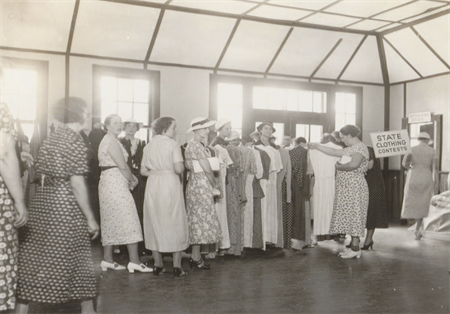- Call Us
- 501-682-6900
- Write Us
- state.archives@arkansas.gov
- Visit Us
- 1 Capitol Mall Suite 2B-215, Little Rock, AR 72201
Exhibits
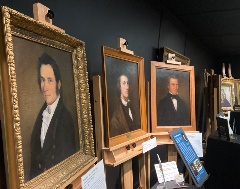
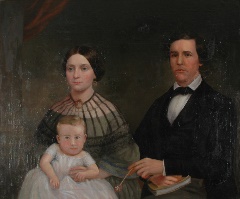
Brushed into history: Portraits from the collections of the Arkansas State Archives
Brushed into history: Portraits from the collections of the Arkansas State Archives features a selection of paintings from the Arkansas State Archives. The subjects of the portraits span four centuries; they include early explorers, government officials, families and business leaders. Prominent Arkansas artists, such as Edward Payson Washbourne, Henry Byrd and Jenny Delony, offer an intimate look into the past.
The portraits include two by one of the state’s earliest artists of note, Edward Payson Washbourne, famed for his “Arkansas Traveler” genre painting. The artist’s self-portrait is paired with his representation of his father, Presbyterian missionary Cephas Washburn, co-founder of Dwight Mission in 1820.
A painting attributed to Henry Bryd depicts Arkansas lawyer, lawmaker, Governor, U.S. Senator and Attorney General Augustus Garland, with his wife, Sarah Virginia Garland, who holds one of their children. Governor George Donaghey’s portrait was painted by Jenny Delony Rice Myerowitz, the first woman artist from Arkansas to rise to national and international prominence. Ben Brantley’s 1935 painting is a copy of a much older portrait of Henri de Tonti, who established the first permanent European settlement in the lower Mississippi River Valley in 1686 at Arkansas Post.
Other historic subjects include William E. Woodruff, founder of the Arkansas Gazette; John Pope, third Territorial Governor of Arkansas; Maria Toncray Watkins Stevenson, an early Arkansas pioneer; and Nancy Hall, the first woman to be elected to a constitutional office in Arkansas.
These paintings offer a glimpse into the extensive collections of the State Archives, acquired through over a century of collecting and preserving the history of the state.
The exhibit may be viewed at the Arkansas State Archives on the second floor of One Capitol Mall in Little Rock, just west of the Arkansas State Capitol.
The Arkansas State Archives offers several traveling exhibits that are displayed at museums, libraries, archives, schools, historical societies and other educational or cultural institutions around the state at no cost. These banner-style exhibits must be booked in advance as well as picked up and dropped off at the Arkansas State Archives in Little Rock. Each banner pulls out of a stand on the floor like a window shade and stays extended with a metal pole which latches to the top and base. Since each banner stands alone, the exhibit panels can be arranged in many configurations, whether linearly, at angles, back to back or in triangular or square groupings.
TERRITORIAL ARKANSAS: THE WILD WESTERN FRONTIER
"Territorial Arkansas: The Wild Western Frontier" explores the history of Arkansas Territory through the collections of the Arkansas State Archives. Established in 1819, Arkansas Territory was a wild frontier on the western edge of the United States, where politicians settled debates by deadly duels. The sparsely populated land saw an influx of settlers arriving over land and rivers to establish small communities and isolated homesteads, develop territorial and county governments, farm the land and start new businesses. Initially, Arkansas Territory included what is now Oklahoma, but through changes in boundary lines and the relocation of Native Americans further and further west, the territory’s land was reduced to its present size in 1828. After 17 years as a territory, Arkansas was admitted to the Union as the 25th state on June 15, 1836.
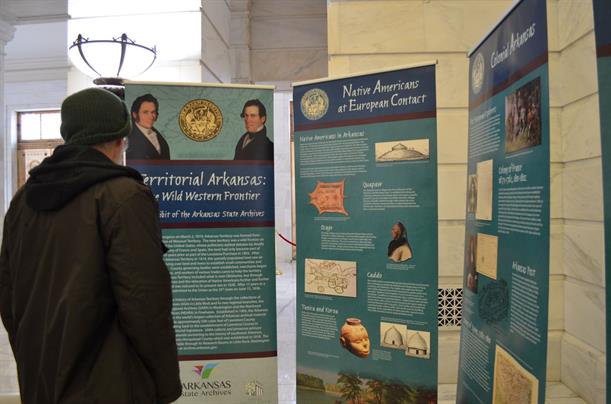
This exhibit consists of 15 banners stands. The extended banner stands on display are each 38"W x 86"H x 8.6"D. The banner stands in their individual cases for transport are each 40"L x 10"H x 5"D.
THE GREAT WAR: ARKANSAS IN WORLD WAR I
"The Great War: Arkansas in World War I" showcases images from the Arkansas State Archives' holdings, including original documents, photographs, posters, maps and historical objects that tell the story of Arkansas's role during World War I, at home
and on the battlefields. The panels cover the chronology of the war as well as various facets of the conflict: training troops in Arkansas, actions overseas, the Home Front, providing for the war, healthcare and Arkansas heroes.
This
exhibit consists of 12 banner stands. The extended banner stands on display are each 85" H x 37.5" W x 8" D. The banner stands in their individual cases for transport are each 39.5" L x 8.5” W x 3.5" H. A free standing literature stand/table
is also available for this exhibit.
FOUGHT IN EARNEST: CIVIL WAR ARKANSAS
The Arkansas State Archives' traveling exhibit, "Fought in earnest: Civil War Arkansas," chronicles major historical events in Arkansas between 1861 and 1865, in addition to the circumstances leading up to war. Images from Arkansas State Archives holdings, including original documents, photographs, maps, drawings, paintings and artifacts, illustrate the story of the Civil War in Arkansas. These primary source materials offer a first-hand look at the lives of Confederate and Union soldiers, government officials and civilians in Arkansas during this tumultuous time.
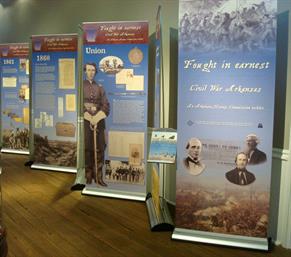
This exhibit consists of 15 banner stands. The extended banner stands on display are each 87 ¼” H x 35 ¼” W x 10” D. The collapsed banner stands in their individual cases are each 37 ½”L x 11 ¼” W x 4”D. A literature stand that attaches to the base of the first banner stand is also available for this exhibit.
ARKANSAS AFRICAN AMERICAN LEGISLATORS, 1868-1893
This traveling exhibit, produced by the Arkansas State Archives and The Black History Commission of Arkansas, tells the story of the 85 African Americans who served in the Arkansas General Assembly in the 19th century. After the Civil War, Arkansas adopted a new constitution in 1868, and its provisions included giving black males the right to vote and hold public office. African American lawyers, merchants, ministers, educators, farmers and other professionals served in the Arkansas General Assembly. Photographs of f46 of the 85 legislators are an integral part of this exhibit’s display. Also featured is a complete listing of the legislators and a short history of post-Civil War and election law “reforms” that effectively ended African Americans’ election to legislative positions until the 1970s.
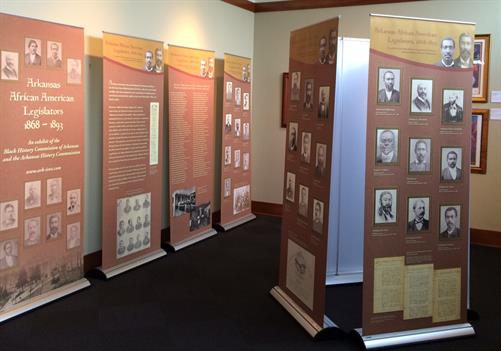
This exhibit consists of eight banner stands. The extended banner stands on display are each 87 ¼” H x 35 ¼” W x 10” D. The collapsed banner stands in their individual cases for transport are each 37 ½”L x 11 ¼” W x 4”D. A literature stand that attaches to the base of the first banner stand is available for this exhibit. Plastic rulers listing the African Americans who served in the Arkansas State Legislators between 1868 and 1893 are also available at no cost to educators.
“WE THE PEOPLE”: CONSTITUTIONS OF THE STATE OF ARKANSAS
“We the People”: Constitutions of the State of Arkansas explores the history of each Arkansas state constitution and provides insight into our current, much-amended constitution. Constitutions, federal and state alike, establish fundamental principles that prescribe the nature, functions and limits of government. Arkansas has embraced five constitutions since 1836. Each coincided with a change in the state’s political status: statehood in 1836, joining the Confederate States of America during the Civil War in 1861, returning to the Union near the end of the Civil War in 1864, Reconstruction in 1868 and reaction to Reconstruction in 1874. The 1874 document, amended over 100 times, remains the foundation of the Arkansas code. This exhibit debuted in 2024 for the commemoration of the 150th anniversary of the 1874 Arkansas Constitution.
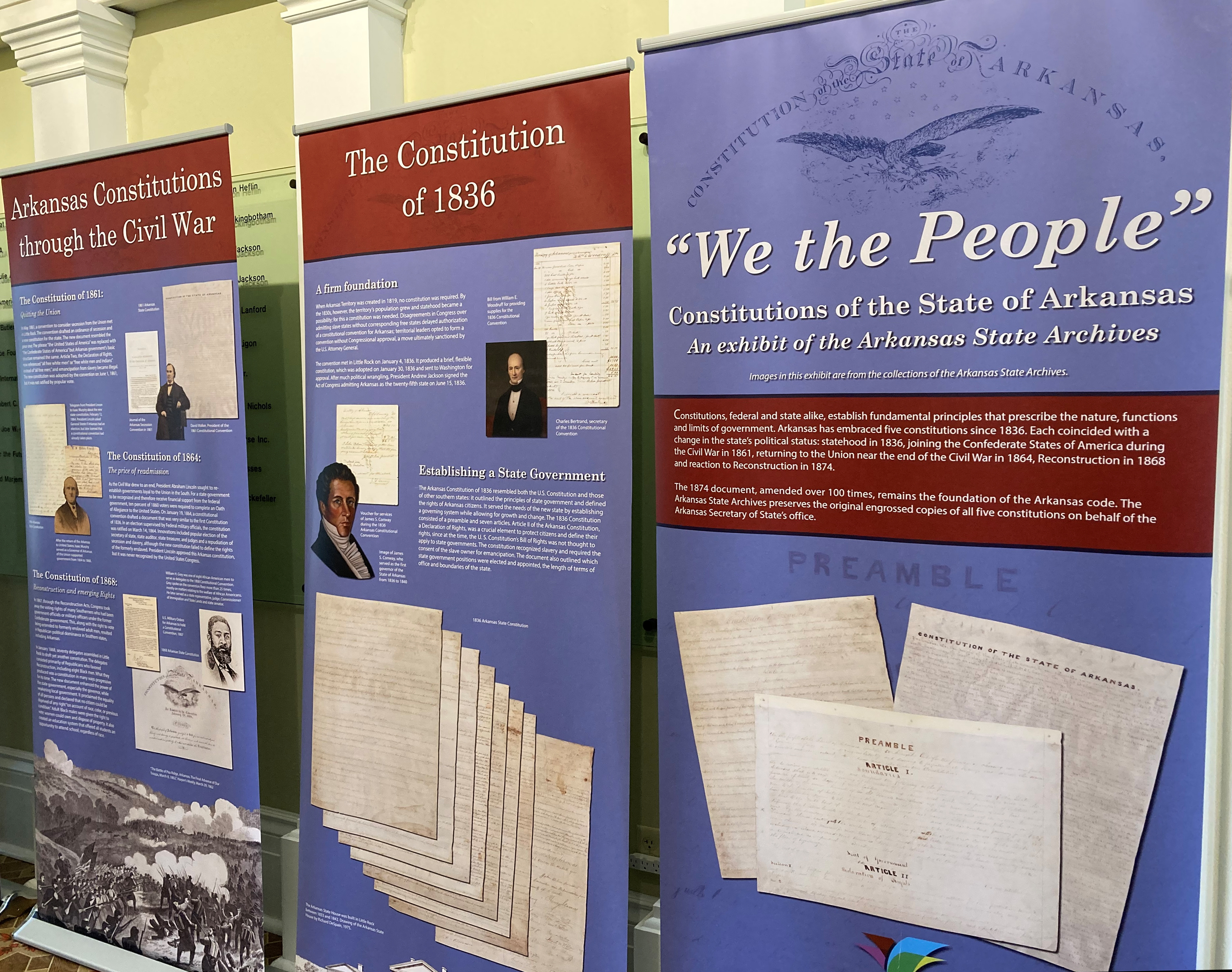
This exhibit consists of 7 banners stands and a reproduction of the 1874 Arkansas Constitution on a stand. The extended banner stands on display are each 38"W x 86"H x 8.6"D. The banner stands in their individual cases for transport are each 40"L x 10"H x 5"D.
“PROMISES AND STIPULATIONS”: U.S. TREATIES WITH THE QUAPAW NATION
“Promises and Stipulations”: U.S. Treaties with the Quapaw Nation examines the history of a series of U.S. treaties which resulted in the Quapaw ceding their land to the U.S. and being removed to present-day Oklahoma.
The Quapaw called part of present-day southeastern Arkansas, particularly the area around the confluence of the Arkansas and Mississippi rivers, their homeland for many generations. The Quapaw built a relationship with the French (and, later,
Spanish) settlers at Arkansas Post. After the Louisiana Purchase in 1803, the United States expanded settlement of the areas west of the Mississippi and entered into treaties with tribes to move them further westward, onto assigned lands in
the Indian Territory. Through a series of treaties with the United States, the Quapaw Nation ceded their land and were removed first to northern Louisiana, then to the Indian Territory. The originals of the treaties between the native nations
and the United States government are preserved by the National Archives and Records Administration including those with the Quapaw, dating from 1818, 1824, 1833, 1835 and 1867. A duplicate official copy of the Quapaw Treaty of 1824, signed
by Arkansas Territory Acting Governor Robert Crittenden, is also preserved by the Arkansas State Archives.
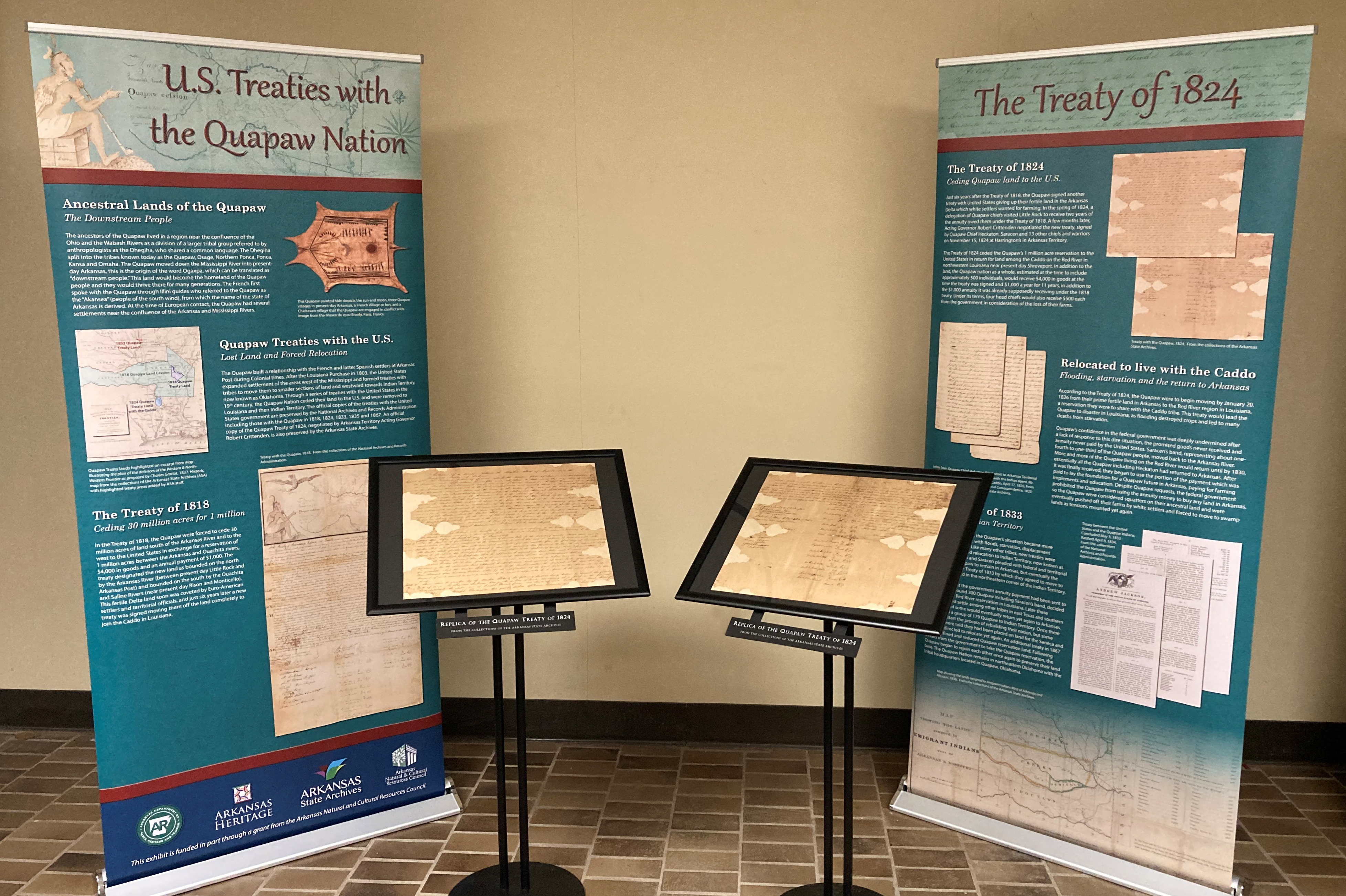
This exhibit consists of 2 banners and 2 framed pages on stands of reproductions of the Quapaw Treaty of 1824. The extended banner stands on display are each 38"W x 86"H x 8.6"D. The banner stands in their individual cases for transport are each 40"L x 10"H x 5"D. The framed pages on stands consist of: two stands (each stand- 14”W x 39”H x 14”D) and two frames in boxes (each box - 22 1/2”W x 28 ½”L x 3”D).
The Arkansas State Archives has partnered with Google Arts and Culture to create the following online exhibits.
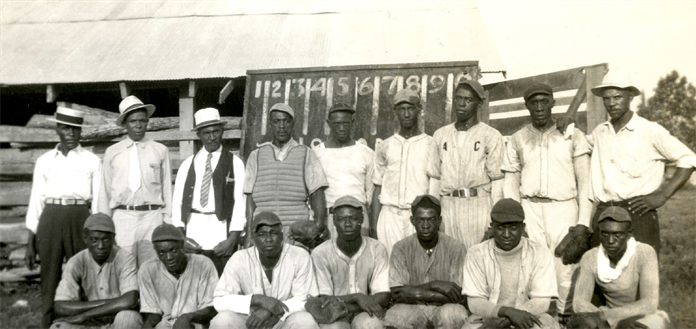
ACROSS THE HORIZON
This photographic exhibit illustrates the story of a small black farming community in Grady, Arkansas, in the late 1930s.
ARKANSAS IN THE GREAT WAR, PART I: MOBILIZING THE STATE FOR WAR
Part one of Arkansas in the Great War examines Arkansas's progressive and industrial status on the eve of war and how Arkansans pulled together to prepare for the time ahead.
ARKANSAS IN THE GREAT WAR, PART II: THE WAR AT HOME
Part two of Arkansas in the Great War explores what it was like for average Arkansans, being asked to make economic sacrifices at home in order to support the war effort as well as how the Arkansas Council of Defense endeavored to reach out to women and African Americans to enlist them in the war effort.
ARKANSAS IN THE GREAT WAR, PART III: IN THE TRENCHES
Part three of the Arkansas in the Great War discusses the lives of ordinary German-born Arkansans and examines the impact that the war had on their lives. It also explores through letters the lives of Arkansans overseas as they faced the horrors of war and delves into the impact that the war had on Arkansas society in the years immediately after the war.
HOME DEMONSTRATION CLUBS SCRAPBOOKS
The Arkansas State Archives' 25 Home Demonstration Clubs scrapbooks (1933-1966) offer insight into the operations of the Home Demonstration Council camps and the camps' impact on the lives of Arkansas women and their families.
